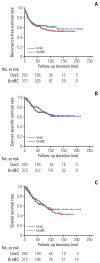TNM-Based Head-to-Head Comparison of Urachal Carcinoma and Urothelial Bladder Cancer: Stage-Matched Analysis of a Large Multicenter National Cohort
- PMID: 37080605
- PMCID: PMC10582549
- DOI: 10.4143/crt.2023.417
TNM-Based Head-to-Head Comparison of Urachal Carcinoma and Urothelial Bladder Cancer: Stage-Matched Analysis of a Large Multicenter National Cohort
Abstract
Purpose: Outcome analysis of urachal cancer (UraC) is limited due to the scarcity of cases and different staging methods compared to urothelial bladder cancer (UroBC). We attempted to assess survival outcomes of UraC and compare to UroBC after stage-matched analyses.
Materials and methods: Total 203 UraC patients from a multicenter database and 373 UroBC patients in single institution from 2000 to 2018 were enrolled (median follow-up, 32 months). Sheldon stage conversion to corresponding TNM staging for UraC was conducted for head-to-head comparison to UroBC. Perioperative clinical variables and pathological results were recorded. Stage-matched analyses for survival by stage were conducted.
Results: UraC patients were younger (mean age, 54 vs. 67 years; p < 0.001), with 163 patients (80.3%) receiving partial cystectomy and 23 patients (11.3%) radical cystectomy. UraC was more likely to harbor ≥ pT3a tumors (78.8% vs. 41.8%). While 5-year recurrence-free survival, cancer-specific survival (CSS) and overall survival were comparable between two groups (63.4%, 67%, and 62.1% in UraC and 61.5%, 75.9%, and 67.8% in UroBC, respectively), generally favorable prognosis for UraC in lower stages (pT1-2) but unfavorable outcomes in higher stages (pT4) compared to UroBC was observed, although only 5-year CSS in ≥ pT4 showed statistical significance (p=0.028). Body mass index (hazard ratio [HR], 0.929), diabetes mellitus (HR, 1.921), pathologic T category (HR, 3.846), and lymphovascular invasion (HR, 1.993) were predictors of CSS for all patients.
Conclusion: Despite differing histology, UraC has comparable prognosis to UroBC with relatively favorable outcome in low stages but worse prognosis in higher stages. The presented system may be useful for future grading and risk stratification of UraC.
Keywords: Cystectomy; Neoplasm staging; Survival analysis; TNM classification; Urachal cancer; Urinary bladder neoplasms.
Conflict of interest statement
Conflict of interest relevant to this article was not reported.
Figures


Similar articles
-
Gender-specific differences in cancer-specific survival after radical cystectomy for patients with urothelial carcinoma of the urinary bladder in pathologic tumor stage T4a.Urol Oncol. 2013 Oct;31(7):1141-7. doi: 10.1016/j.urolonc.2011.09.011. Epub 2011 Nov 6. Urol Oncol. 2013. PMID: 22056404
-
Predictive value of combined immunohistochemical markers in patients with pT1 urothelial carcinoma at radical cystectomy.J Urol. 2009 Jul;182(1):78-84; discussion 84. doi: 10.1016/j.juro.2009.02.125. Epub 2009 May 17. J Urol. 2009. PMID: 19447418
-
Survival benefit of chemotherapy in a contemporary cohort of metastatic urachal carcinoma.Urol Oncol. 2022 Apr;40(4):165.e9-165.e15. doi: 10.1016/j.urolonc.2021.09.008. Epub 2021 Oct 20. Urol Oncol. 2022. PMID: 34686429
-
The Cancer of the Bladder Risk Assessment (COBRA) score accurately predicts cancer-specific survival after radical cystectomy: external validation and lymphovascular invasion assessment value to improve its performance.Clin Genitourin Cancer. 2022 Jun;20(3):199-209. doi: 10.1016/j.clgc.2021.12.010. Epub 2021 Dec 16. Clin Genitourin Cancer. 2022. PMID: 35042666 Review.
-
Clinicopathological factors in bladder cancer for cancer-specific survival outcomes following radical cystectomy: a systematic review and meta-analysis.BMC Cancer. 2019 Jul 19;19(1):716. doi: 10.1186/s12885-019-5924-6. BMC Cancer. 2019. PMID: 31324162 Free PMC article.
Cited by
-
Urachal Carcinomas: A Comprehensive Systematic Review and Meta-analysis.Int Braz J Urol. 2025 May-Jun;51(3):e20240665. doi: 10.1590/S1677-5538.IBJU.2024.0665. Int Braz J Urol. 2025. PMID: 39908206 Free PMC article. Review.
-
Robotic-assisted approaches to urachal carcinoma: A comprehensive systematic review of the safety and efficacy outcomes.BJUI Compass. 2024 Feb 1;5(3):327-333. doi: 10.1002/bco2.333. eCollection 2024 Mar. BJUI Compass. 2024. PMID: 38481673 Free PMC article. Review.
References
-
- Paner GP, McKenney JK, Barkan GA, Yao JL, Frankel WL, Sebo TJ, et al. Immunohistochemical analysis in a morphologic spectrum of urachal epithelial neoplasms: diagnostic implications and pitfalls. Am J Surg Pathol. 2011;35:787–98. - PubMed
-
- Bruins HM, Visser O, Ploeg M, Hulsbergen-van de Kaa CA, Kiemeney LA, Witjes JA. The clinical epidemiology of urachal carcinoma: results of a large, population based study. J Urol. 2012;188:1102–7. - PubMed
-
- Szarvas T, Modos O, Niedworok C, Reis H, Szendroi A, Szasz MA, et al. Clinical, prognostic, and therapeutic aspects of urachal carcinoma: a comprehensive review with meta-analysis of 1,010 cases. Urol Oncol. 2016;34:388–98. - PubMed
-
- Wright JL, Porter MP, Li CI, Lange PH, Lin DW. Differences in survival among patients with urachal and nonurachal adenocarcinomas of the bladder. Cancer. 2006;107:721–8. - PubMed
-
- Cho SY, Moon KC, Park JH, Kwak C, Kim HH, Ku JH. Outcomes of Korean patients with clinically localized urachal or non-urachal adenocarcinoma of the bladder. Urol Oncol. 2013;31:24–31. - PubMed
Publication types
MeSH terms
Supplementary concepts
Grants and funding
LinkOut - more resources
Full Text Sources
Medical

